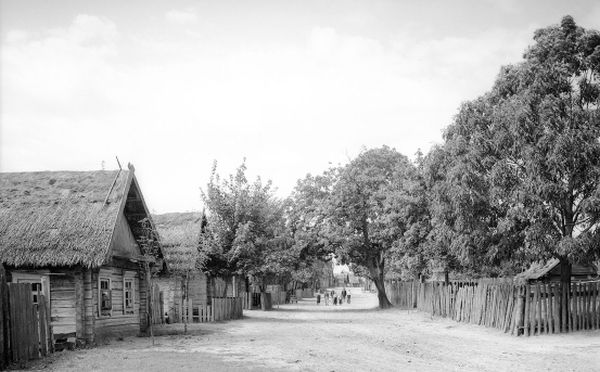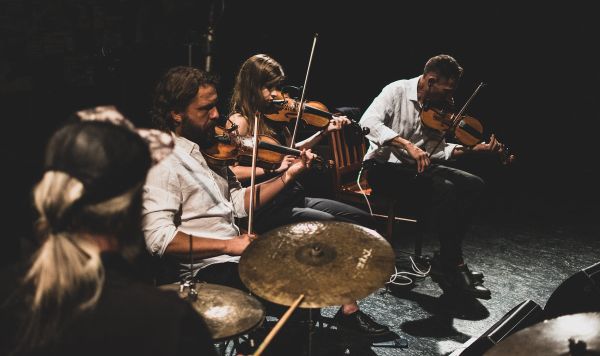

Warsaw Village Band & Bassałyki
Radical Polish Ansambl
Maria Siwiec Reviews by Andrew Cronshaw
Poland is a big country, with a range of regional traditional musics, including those of long-established populations with origins in the cultures of the seven other countries surrounding its present borders. In recent years, mainly since the dawn of the digital age of CDs and sound files, more aspects of that patchwork of traditions have been represented in recordings. Notables in this work include, with a variety of approaches and regional viewpoints, Andrzej Bienkowski with his Muzyka Odnaleziona label, Karolina Cicha, Trebunie-Tutki, Janusz Prusinowski, Maciej Rychły, Maria Pomianowska, Orkiestra Sw.Mikolaja, Adam Strug, Witold Broda, and bands and individuals performing Polish klezmer music. While the Tatra highlanders family band Trebunie-Tutki was one of the first to create interest, indeed some amusement, abroad on the ‘world-music’ scene in its collaboration with Jamaican reggae band the Twinkle Brothers beginning in the early 1990s, later that decade it was Kapela ze wsi Warszawa (The Warsaw Village Band) that made the main international scene breakthrough. (Both groups were very much prompted, encouraged and supported by Polish Radio presenter Włodzimierz Kleszcz). The Warsaw Village Band has been through a lot of changes, personnel and projects since that first album, steered throughout by Maciej Szajkowski, the only member remaining from its first line-up. He’s a man of many activities including Polish Radio presenter, frame-drum player, producer, event organiser, organisation founder, and assembler of bands. The band’s line-up for its latest album, Sploty (‘Twines’), features pretty much the same personnel it has for over a decade: three female singers, who also play fiddles, hammered dulcimer, hurdygurdy and the two distinctive Polish types of fiddle - Płock fiddle and suka - that have recently been rediscovered and revived, with the four males on frame drums, bass drum, double bass, and trumpet or flügelhorn, a feature that has always been a welcome addition on some past albums and is joined for this album by a guest tenor and baritone saxist to form a brass section. But the defining aspect this time comes from, and via, the band’s long-time sound engineer and eighth member Mariusz Dziurawiec, who’s also a DJ and sound-artist, and he’s brought in three others from that electronics, sampling and percussion world - Grzegorz Rytka, Michał Marecki and Jerzy Markuszewski, who constitute Bassałyki. The Warsaw Village Band is far from alone in having been through a remix project phase in the past, but this album isn’t that; it’s a much more integrated, comprehending piece of work, not existing tracks chopped up as 4/4 thud-fodder by outsiders.
It opens, in “Siwa Zezulejko” (‘Oh, grey-feathered cuckooling’) with a repeating rhythm pattern on synths and samples spiced by repeat-echoed fiddle, over which soars a female vocal phrase in traditional style, moving to a horns motif and slithering fiddle solo with spacy synth slides before returning to the vocal line. “Kalinowy Mostek” (‘Wayfarer-tree bridge’) has more of a folk-rock feel, with hurdy-gurdy then brass and synth swirls to a rolling, slightly reggae beat, and multiple female vocals which, as throughout, have the edgy sound usually described as ‘white-voice’. Urgent chopping and sliding fiddles and a dub beat with frame-drums, an occasional horn motif and synth squiggles give underlying pulse to the slow vocals in “Zimna Rose” (‘Cold dew’). “Grady i pioruny” (‘Hailstones and thunderbolts’) is a Hasidic dance-song, with skipping hammered dulcimer and rhythmic bounce, before moving to a slower part for the dulcimer, ominous drone and dubby slices of impressionistic squeeing fiddles and clarinet, returning to bounce with a scratchy fiddle ensemble and the vocals. And so it goes as the eleven tracks progress - Polish folk songs and instrumentation with a dub sensibility. Conceptually, in some ways, a descendant of Trebunie-Tutki and the Twinkle Brothers’ 1992 Higher Heights - Twinkle Inna Polish Stylee album, though dubbier and modernised, Sploty is one of the WVB’s most appealing projects, and as I write this it’s number one in World Music Charts Europe. *
 Equally progressive with Polish traditional music, but with a very different approach, is Radical Polish Ansambl. Six fiddlers and a drummer, sitting in a circle making ensemble music that digs into the wild sounds and rhythms of Polish village fiddle music, but… well, it’s not often that I choose to quote a promo blurb, but theirs is hype-free and explains this latest album of theirs, Nierozpoznana Wieś, thus: “The concept of “unrecognised village” inspired us to create music and capture it in a recording. We decided to share our tale of experiences with music coming from the villages by making our own compositions. We find the country and its villages an uncharted, intriguing phenomenon, bristling with contradictions. The music from the villages does not leave us indifferent either. It is inspiring and very much alive, simple yet nuanced and enigmatic. It makes you want to go on investigating it, and tell its tale in ever new versions! We hope that you will hear here not only Radical Polish Ansambl, but also the previous generations of village artists, who responded creatively to the needs of their time. Perhaps you, too, will imagine where communing with this universal art might take us to in future.”
And that’s just what they do. There are all the wiggling, dancing, staggering rhythms, the melodic shapes, the repetitiveness of village fiddling with its abrasiveness, and sometimes with the flat thuddings of its characteristic stick-bashed frame drum, bass drum and occasionally other percussive sounds. But these are pieces, be they oberek/mazurek dance-tempos or slow and reflective, that lead and engage the ear with a meaningful, shaped intentionality beyond the functionality of village dance music. Intelligent, intense and rather inspiring. To hear recordings of the traditional sources of these musics, some singers and players still living, some now passed, a sampling is recommended of the works of the aforementioned Muzyka Odnaleziona (‘Music Found’) label and archive created by artist Andrzej Bienkowski, a great support and influence in the renewal of interest in village musics. While it’s now given up on making physical CDs, some are still available from its website, and those that aren’t are listenable and buyable as digital files.
*
Another important foundation, archive and label for Poland’s traditional music is Muzyka Zakorzeniona (Rooted Music). It has just released, among others, Wesele, a download album of the spirited singing of Maria Siwiec from the village of Gałki Rusinowskie, solo and with the fiddle, frame-drum and chugging rough-hewn cello-sized bowed ‘basy’ of trio Niwiński or fiddle and frame-drum duo Agopsowicz. She’s been a leading figure among the surviving tradition-bearers, living all her life in her village but performing around Poland and beyond, solo or leading the local ensemble Gołcunecki, and has made several albums. For this one, from her large repertoire she has chosen songs from the village weddings of her youth.
Useful resources:
Further reading:
Search RootsWorld
|